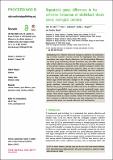Por favor, use este identificador para citar o enlazar a este item:
http://hdl.handle.net/10261/346188COMPARTIR / EXPORTAR:
 SHARE SHARE
 CORE
BASE CORE
BASE
|
|
| Visualizar otros formatos: MARC | Dublin Core | RDF | ORE | MODS | METS | DIDL | DATACITE | |

| Título: | Repeatable group differences in the collective behaviour of stickleback shoals across ecological contexts |
Autor: | Jolles, Jolle W.; Laskowski, Kate L.; Boogert, Neeltje J.; Manica, Andrea | Palabras clave: | Stickleback Collective behaviour Group differences Group personality Schooling; sociality |
Fecha de publicación: | 14-feb-2018 | Editor: | Royal Society (Great Britain) | Citación: | Proceedings of the Royal Society of London - B 285(1872): 20172629 (2018) | Resumen: | Establishing how collective behaviour emerges is central to our understanding of animal societies. Previous research has highlighted how universal interaction rules shape collective behaviour, and that individual differences can drive group functioning. Groups themselves may also differ considerably in their collective behaviour, but little is known about the consistency of such group variation, especially across different ecological contexts that may alter individuals' behavioural responses. Here, we test if randomly composed groups of sticklebacks differ consistently from one another in both their structure and movement dynamics across an open environment, an environment with food, and an environment with food and shelter. Based on high-resolution tracking data of the free-swimming shoals, we found large context-associated changes in the average behaviour of the groups. But despite these changes and limited social familiarity among group members, substantial and predictable behavioural differences between the groups persisted both within and across the different contexts (group-level repeatability): some groups moved consistently faster, more cohesively, showed stronger alignment and/or clearer leadership than other groups. These results suggest that among-group heterogeneity could be a widespread feature in animal societies. Future work that considers group-level variation in collective behaviour may help understand the selective pressures that shape how animal collectives form and function. | Versión del editor: | https://doi.org/10.1098/rspb.2017.2629 | URI: | http://hdl.handle.net/10261/346188 | DOI: | 10.1098/rspb.2017.2629 | ISSN: | 0962-8452 | E-ISSN: | 1471-2954 |
| Aparece en las colecciones: | (CEAB) Artículos |
Ficheros en este ítem:
| Fichero | Descripción | Tamaño | Formato | |
|---|---|---|---|---|
| ecological-contexts.pdf | 700,51 kB | Adobe PDF |  Visualizar/Abrir |
CORE Recommender
PubMed Central
Citations
24
checked on 22-abr-2024
SCOPUSTM
Citations
51
checked on 24-abr-2024
WEB OF SCIENCETM
Citations
41
checked on 24-feb-2024
Page view(s)
13
checked on 27-abr-2024
Download(s)
4
checked on 27-abr-2024

